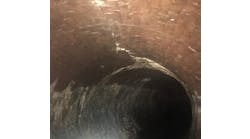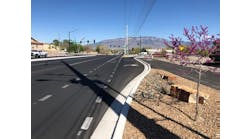The Las Vegas Wash is a 12-mile stretch of land in the southeast portion of the Las Vegas Valley. The Wash is the primary drainage channel for all stormwater, urban runoff, shallow groundwater and highly treated effluent in the bowl-shaped Las Vegas Valley.
Its wetlands have served as a polishing mechanism as urban flows enter the Wash on the way to Lake Mead and the Colorado River system. Since the 1970s the wetlands have decreased from 2,000 acres to approximately 200 acres.
In addition to the important role the Wash plays in the watershed, the Wash’s history dates back thousands of years. Early settlers in the Vegas Valley farmed and mined near the Wash, contributing to the economy in the 1900s. The Wash also provides a habitat for many plant and animal species.
In response to growing concerns over water quality issues in the Wash and Lake Mead, the Las Vegas Wash Coordination Committee was formed in 1998. The 28-member committee, composed of local, state and federal agencies, members of the public, business people and representatives of environmental groups, is charged with researching and analyzing issues related to the Wash and developing a comprehensive adaptive management plan that recommends solutions to the problems.
The projects currently underway, as well as those planned for the future, are a direct result of the recommendations from the Las Vegas Wash Comprehensive Adaptive Management Plan. These projects include wetlands construction, erosion control and environmental monitoring.
Demonstration Wetlands
As part of the cooperative efforts among the City of Henderson, the Bureau of Reclamation and the Las Vegas Wash Coordination Committee, a constructed wetlands demonstration project is being created at the City of Henderson’s Water Reclamation Facility, near the Henderson Bird Viewing Preserve.
The project team is retrofitting a retention pond at the Henderson facility for use as a constructed wetland pond. The goal of the project is to determine the wetland’s effect on water quality in a controlled environment. Project planners hope the demonstration wetlands will serve as a guide for future planting projects along the Las Vegas Wash.
A demonstration wetlands is a constructed wetlands–or group of basins containing water, substrate and wetland vegetation–that is designed to treat wastewater, stormwater, urban runoff and agricultural wastewater. As with natural wetlands, constructed wetlands have slow-moving flow and shallow water depths that allow sediments to settle as the water passes through the wetlands. This creates an environment for a diverse community of microorganisms that aid in the water quality improvements. They often are used as educational and research laboratories, for bird watching and landscape enhancement.
The constructed wetland design at the project includes
• A 7.8-acre triangular-shaped pond is located in the Henderson Water Reclamation Facility.
• The pond features three loafing islands and 11 hummocks (submerged islands) consisting of 5 percent of water surface area. Loafing islands are located above the water, and they help stabilize the soil. They are excellent habitats for wading birds and also can be instrumental in keeping invading species away.
• Flows will enter the pond on its west side and flow perpendicular to the emergent beds that will consist of 20 percent of the water surface. Emergent beds are plants rooted in shallow water having most of the vegetative growth above water.
The vegetation used in constructed wetlands plays a vital role in water quality improvements. The types of species planted depend on the designated flow (i.e., stormwater, urban runoff and treated wastewater) and the treatment objective. It also is important to choose local, native wetland species because they are adapted to the local climate, soil and surrounding plant and animal communities. Many of the plants have known benefits of removing metals and other pollutants, and others provide food and cover for many species of birds. Table 1 shows the plant species that have been planted in the constructed wetlands during August of 2001.
Though this demonstration wetlands currently is nourished only by highly treated wastewater, it lays the groundwork for determining the effectiveness of wetlands on other flows such as urban runoff. Wetland vegetation helps reduce levels of nitrogen, phosphorus and total suspended solids in water.
Erosion Control
Erosion is one of the most important issues relating to Las Vegas Wash. Erosion causes instability in the Wash banks. One of the ways the project is dealing with erosion is by placing grade control structures throughout the Wash. Twenty-two structures will be required to stabilize the Wash. Currently, there are four structures in place and five more in the planning phase.
Achieving Equilibrium
Increasing and variable daily flows, highly erodable soils, water quality concerns, the need to protect wildlife and other environmental concerns present formidable challenges to controlling erosion in the Wash. However, efforts currently are underway to promote channel stabilization by improving channel bed downcutting, reducing stream bank erosion, armoring the channel with vegetation, balancing sediment transport and restoring the ecosystem.
The grade control structures will focus on establishing predictable flows, reducing erosion potential and increasing vegetation. As shown in Table 2, planning and design efforts have focused on the present flows and grades and the necessary flows and grades to promote stability.
Water Quality Monitoring
Las Vegas Wash monitoring is being done to establish data that reflects the current baseline water quality conditions in the Wash. This will provide a baseline mark for comparison as the wash channel is stabilized and wetland areas are restored. In addition, the data collected in this study will be used when interpreting the results of the macroinvertebrate study that is being performed at the same time.
Samples will be collected at eight sites along the Wash. Data collection and sampling procedures for each of the eight locations will be performed using identical methodology. A Hydrolab multi-parameter water quality probe will be used to measure water temperature, dissolved oxygen, pH and electrical conductivity on an hourly basis. Data collected will be downloaded weekly and maintained in a database by the Las Vegas Wash team staff. In addition, samples will be collected on a monthly basis at all sites for heavy metals, cation-anion, perchlorate, nutrient and bacteria.
The macroinvertebrate study will determine how erosion control structures and the associated wetlands impact the macroinvertebrate fauna of the wash. Macroinvertebrate refers to the group of animals without a defined backbone. Examples of animals in this group are crustaceans, mollusks, worms, gastropods and insects. The insects serve as biological indicators. The greater abundance and diversity of insects present, the better the stream health.
Through the efforts of the Las Vegas Wash Coordination Committee, tough issues such as erosion, habitat loss and water quality are being tackled.
For more information on the Las Vegas Wash Coordination Committee, go to www.lvwash.org or 702-822-3300.


